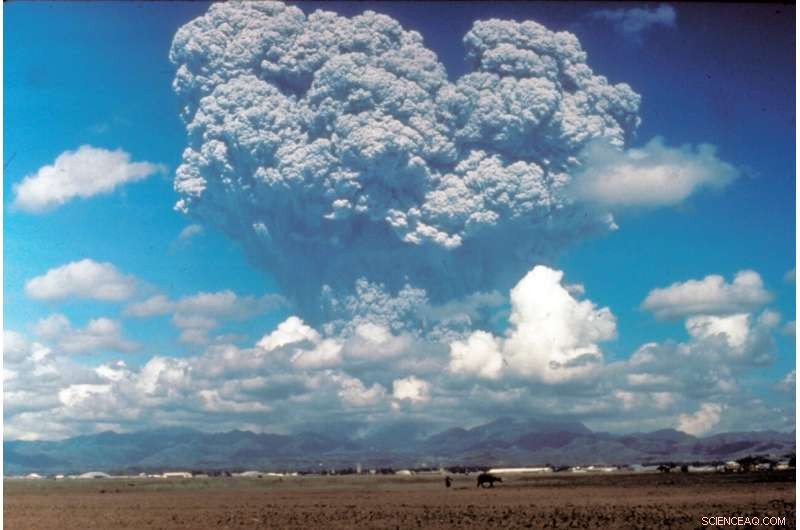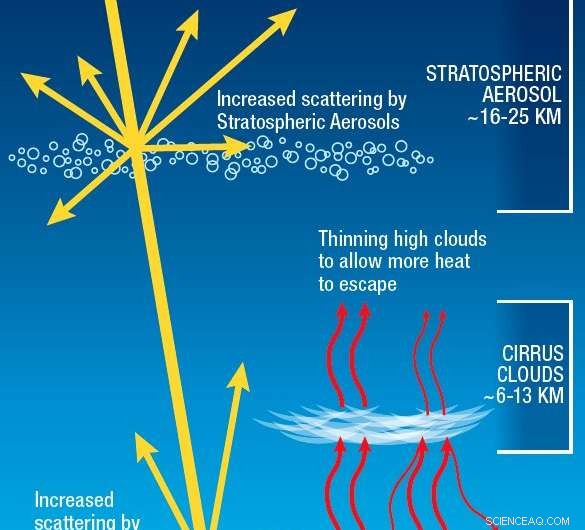
När Mount Pinatubo utbröt 1991, den släppte ut 20 miljoner ton svaveldioxid i atmosfären. Under månaderna efter utbrottet aerosolerna bildade ett globalt lager av svavelsyradis. Globala temperaturer sjönk med cirka 0,4 ° C från 1991–1993. Det är en naturlig form av solgeoingenjör som människor kan försöka efterlikna för att kyla planeten. Upphovsman:Dave Harlow, USA:s geologiska undersökning/Wikimedia Commons/Public Domain
Det låter som något ur en dålig science fiction -film - som artificiellt blockerar solljus för att förhindra att den globala uppvärmningen överhettas. Ändå, en liten grupp forskare studerar alternativet - så att om mänskligheten någonsin behöver använda den, det blir ett välgrundat beslut.
Den senaste rapporten från Intergovernmental Panel on Climate Change (IPCC), släpptes i början av augusti, gjorde det klart att mänskligheten måste vidta omedelbara åtgärder för att stävja den globala uppvärmningen. Det finns hopp om att internationella klimatsamtal i Glasgow i november äntligen kan resultera i tillräckligt starka utsläppsgränser för växthusgaser för att göra skillnad.
Men för säkerhets skull en internationell grupp forskare, inklusive NTNU:s Helene Muri, har studerat en teknik som kallas solar geoengineering som en sista utväg.
Solar geoengineering är precis vad det låter som, där olika tekniker används för att blockera solljus och kyla jorden. Vanligtvis, tre huvudmetoder - varav ingen för närvarande är tekniskt redo - studeras för deras förmåga att blockera solljus och sänka marktemperaturen. (Se ruta)
Muri, en senior forskare vid universitetets industriella ekologiprogram, har tillbringat det senaste decenniet med att titta på hur solar geoengineering kanske - eller kanske inte - fungerar.
I juni, hon och hennes kollegor från USA, Kina och Storbritannien publicerade en uppsats i Naturmat som använde datormodeller för att bedöma solgeoingenjörers potentiella effekter på jordbruket i en högutsläppsvärld. Deras fynd väckte internationell mediatäckning eftersom de fann att solenergiingenjör i dessa scenarier faktiskt kunde ha en positiv effekt på grödans tillväxt från högre luftfuktighet.
Andra studier som använde enklare modeller fann antingen en begränsad effekt eller förluster för regnfödda grödor, eftersom det kan komma mindre nederbörd med de lägre temperaturerna som följer med solgeoingenjör - beroende på hur tekniken används för att kyla jorden.
Nu, när världen förbereder sig för att debattera gränser för CO 2 utsläpp under november klimatsamtal, det är värt att titta på de åtgärder som undersöks av forskare som Muri - och en bedömning av deras möjliga risker och fallgropar.
Plåster eller tourniquet?
Varje diskussion om solenergiingenjör måste erkänna att det är långt ifrån en perfekt fix, Säger Muri.
"Solar geoengineering, hur bra vi än gör det, kommer aldrig att helt kompensera effekterna av klimatförändringar, " Hon sa.
Problemet är att solenergiingenjörer kan kyla jorden, men blir inte av med överskottet av koldioxid och andra värmefångande ämnen i atmosfären. Och koldioxid gör mer än att bara värma jorden.
Det gödslar växter - vilket kan vara bra - men eftersom mycket av det löses upp i havsvatten, det gör haven surare.
"Det kommer alltid att finnas saker som du inte kan fixa med solar geoengineering, särskilt försurning av havet, "sa hon." Ett surare hav påverkar allt i näringskedjorna i havet, inklusive korallrevsbackar, vilket är fruktansvärt för ekosystemet som helhet. Det blir uppenbart så snart du verkligen börjar titta på det. Det finns ingen silverkula. Det är inte den enda lösningen som kan fixa allt. "
Muri säger att varje diskussion om geoengineering också förutsätter att CO 2 utsläpp kommer att hanteras samtidigt som någon geoingenjör inom solenergi används.
Alan Robock, en klimatforskare vid Rutgers University i USA som är ledare för ett internationellt kooperativt forskningsprojekt med namnet GeoMIP, som Muri är en del av, gick med på.
"Det är inte en lösning på den globala uppvärmningen när den är som bäst. Om den någonsin användes som plåster-eller en tårta-löser det inte rotproblemet, " han sa.
Många okända, men behöver fortfarande veta
Muri säger att det fortfarande är mycket som är okänt om solenergiingenjörer, delvis för att de flesta klimatförändringsforskningar är inriktade på andra frågor än geoengineering.
"Bara för att sätta forskningsnivån i ett sammanhang, under de senaste fem till tio åren, det har publicerats cirka 100 till 130 artiklar per år om solenergiingenjörer, "sa hon." När det gäller klimatförändringar är det mer som 30, 000 papper per år under den perioden. Det viktiga är att det är ett enormt, enormt olika belopp. Det är bara en minoritet av ansträngning och finansiering som går till forskning av geoingenjörer inom solenergi. "
På samma gång, hon säger, de amerikanska nationella akademierna för vetenskaper, Engineering and Medicine publicerade en omfattande rapport om geoengineering av solenergi som sade att det brådskande med de risker som klimatförändringarna innebär innebar att "USA bör driva ett forskningsprogram för geoengineering av solenergi - i samordning med andra nationer, föremål för styrning, and alongside a robust portfolio of climate mitigation and adaptation policies." The report recommended US funding of about $100 million-$200 million over the first five years.
Muri says that climate researchers' main focus needs to remain on climate change itself, because society needs to know what the effects will be, how to adapt, and how to mitigate these effects. Ändå, hon säger, researchers do need to study solar geoengineering to see if it could be helpful as a stopgap measure while the world transitions away from fossil fuels.
"The question is if it could contribute to reduce some level of harm from climate change for a certain period, whilst we are trying to sort out both emissions of CO 2 and concentrations of CO 2 within the climate system, " she said. "Nobody sees it as a one and only solution, but it's not clear yet whether it could be helpful or not. Just nu, there are too many unknowns and uncertainties to really say whether it's overall a good idea or a bad idea."
Robock agrees.
His group at Rutgers University is "doing research to evaluate the risks of doing solar geoengineering versus the risks of not doing it. And that's the information that governments will need in the future to decide whether or not to ever implement it, " he said. "I spend millions of dollars of taxpayer money to do my research. And if I find a danger to society, it's my obligation to warn people about it."

Three main types of solar geoengineering that are now being studied. Credit:US National Academy of Science
A cooler Earth but potentially changed monsoons
Robock's group is looking at the benefits and risks of using stratospheric aerosols to cool the planet, which emulate a volcanic eruption.
"Benefit number one would be, if you could do it, you would reduce global warming, and many of its risks, " Robock said. "We know that if you could get the aerosols up there, it would work because it doesn't involve creating or affecting clouds in the troposphere, it's just putting a shield up there to reflect sunlight."
Researchers know that big volcanic eruptions, like the 1991 eruption of Mount Pinatubo, cooled the Earth. But these natural solar geoengineering experiments have also given them the ability to observe other pitfalls, Robock said.
"We know that there were other things that were not so good; (the eruption) destroyed ozone, " he said. "And you actually get a huge reduction of monsoon rainfall. We observed that after Mount Pinatubo."
Volcanic eruptions only cause the Earth to cool for a year or two, because the aerosols eventually dissipate. Dock, if stratospheric aerosols were to be used as solar geoengineering to cool the Earth, their use could alter monsoon rainfall for a much longer period, which could result in famine, Robock said.
Some modeling has shown that solar geoengineering could in fact have less of an impact on monsoons than global warming, but nevertheless, the issue illustrates just how difficult making these predictions are.
Who decides?
Then there are issues such as insect-borne diseases, like malaria, Muri points out. How would solar geoengineering affect mosquito populations and the potential spread of malaria?
And what if a failure to cut CO 2 emissions and reduce global warming results in devastating heat waves, where thousands of people die? Is that enough to outweigh other negatives?
"There are still so many areas where we don't know enough, " Hon sa.
Till sist, there are areas that are far outside of what climate scientists who study the physical effects of climate change can predict. The biggest question is who decides what the temperature of the planet should be?
The political decision making surrounding solar geoengineering is daunting, if you consider the difficulty the nations of the world have already had in trying to agree to curb CO 2 utsläpp, Muri said.
"How would one deal with geoengineering in terms of geopolitics and governance?" Muri said. "We need to develop regulations. Who sets the thermostat and how would you go about agreeing on something like that?"
In a companion piece to Muri and her colleague's article on geoengineering and agriculture, Ben Kravitz, an assistant professor at Indiana University's Earth and Atmospheric Sciences Department, summed it up like this.
"Agriculture is one important piece in our understanding of the effects of climate engineering, " he wrote. "Gaining a better picture of the impacts of climate engineering requires looking at numerous effects in addition to food supply, including water security, geopolitics, and environmental justice…. It is important to figure out whether climate engineering would ultimately be more or less risky than climate change (and to whom)."
What is solar geoengineering?
Researchers are studying a number of engineering approaches as possible methods for cooling the planet. The three described here have been identified by a March report by the US National Academies of Sciences, Engineering and Medicine as meriting further study. The three approaches either rely on controlling the amount of sunlight reaching the Earth, or reducing the amount of heat trapped by the atmosphere.
Stratospheric aerosol injection
This technique requires injecting aerosol particles, like sulfates or pre-cursor gases, like sulfur dioxide, into the stratosphere, which is the layer of air 10 to 50 km above the Earth's surface. Most studies are looking at placing aerosols at about 20 km above the Earth, where the particles scatter and reflect solar radiation to cool the planet. This technique mimics what happens with large volcanic eruptions. When Mount Pinatubo erupted in 1991, it sprayed 15 to 20 megatons of sulfur dioxide into the atmosphere, which cooled the Earth by about 0.4 degrees Celsius for two years. För närvarande, dock, there are no planes capable of flying into the stratosphere to do this.
Cirrus cloud thinning
This technique involves spraying chemicals into cirrus clouds, at about 6-13 km above the Earth's surface, to cause them to thin or disappear. The clouds trap heat, so thinning them or reducing them cools the planet by allowing heat to escape the atmosphere. The challenge for this technique is that cirrus clouds are in the region of the atmosphere where jets fly, which could make implementing this measure difficult.
Marine cloud brightening
This approach would add particles to low laying liquid clouds over the ocean to make them thicker and more reflective, which would cool the Earth, if it did not have side effects on other clouds. This mimics what happens now under certain conditions when ships spew pollution into the atmosphere. The effect only works for a few days, and sea salt could be sprayed up from the ocean to seed the clouds.